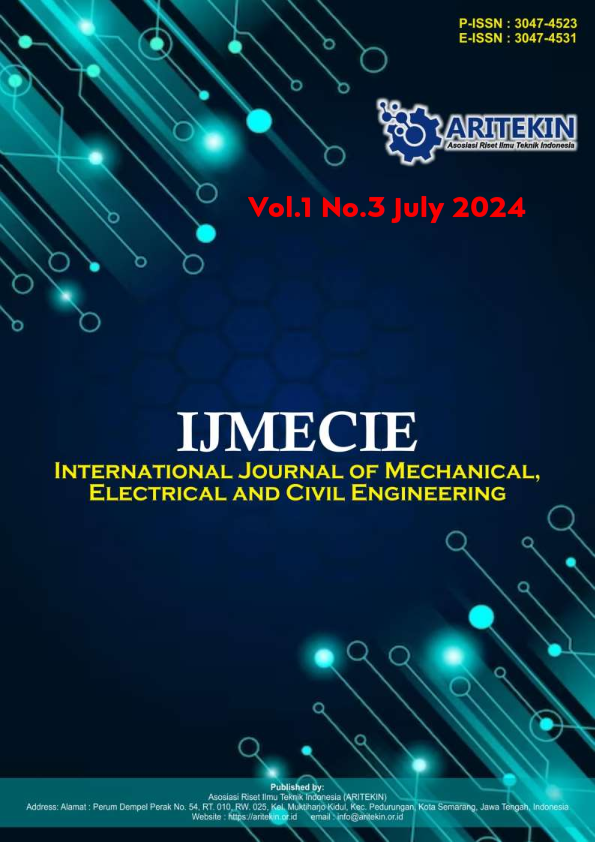Investigation of the Tensile Strength of Sea Sand Concrete Against the Compressive Strength of the Plan
DOI:
https://doi.org/10.61132/ijmecie.v1i3.28Keywords:
Sea sand, Compressive strength, Split tensile strengthAbstract
The availability of sea sand on the beach of Ujung Tape Pinrang is in very large quantities that can be used as materials in making concrete. The purpose of the study is to analyze the characteristics of beach sand, compressive strength and tensile strength produced. An experimental research method in the Civil Engineering Laboratory, University of Muhammadiyah Parepare with a treatment system for ordinary water immersion and analysis of the characteristics of concrete mechanical properties using a compression machine test. The results of the study at the maintenance age of 28 days with a planned compressive strength of 20 MPa produced a compressive strength of 28.29 MPa and a tensile strength of 7.78 MPa, a planned compressive strength of 24 MPa resulted in a compressive strength of 29.98 MPa and a tensile strength of 8.22 MPa, and a planned compressive strength of 28 MPa produces a compressive strength of 31.40 MPa and a tensile strength of 8.44 MPa. The results of the study on compressive strength and tensile strength showed an increase in each increase in planned compressive strength.
References
Adnan, H., Parung, H., Tjaronge, M. W., & Djamaluddin, R. (2017). Compressive strength of marine material mixed concrete. IOP Conference Series: Materials Science and Engineering. http://dx.doi.org/10.1088/1757-899X/271/1/012066
Balsala, O. S. (2018). Pengujian tekan dan tarik belah beton dengan agregat dari Kepulauan Riau. Sipil Statik, 6(9), 715–722. https://ejournal.unsrat.ac.id/index.php/jss/article/view/2046
Elangovan, G., et al. (2018). Strength of concrete using sea sand and micro silica. International Journal of Engineering Research & Technology (IJERT), 6(14), 1–4. https://doi.org/10.17577/IJERTCONV6IS14045
Iduwin, T. (2017). Penggunaan pasir laut terhadap kuat tekan beton Kota Bengkulu. Forum Mekanika, 6(2), 61–136. https://doi.org/10.33322/forummekanika.v6i2.120
Kambu, M. (2019). Uji laboratorium kekuatan tekan beton dengan menggunakan pasir pantai Tanjung Batu – Sorong. Prosiding Seminar Sosial Politik, Bisnis, Akuntansi dan Teknik. Diselenggarakan oleh Lembaga Penelitian dan Pengabdian Masyarakat Universitas Sangga Buana.
M. Yunus., & Imran. (2017). Analisis kuat tekan beton yang menggunakan pasir laut sebagai agregat halus pada beberapa quarry di Kabupaten Fakfak. INTEK, 4(1), 66–72. http://dx.doi.org/10.3196
Saepulloh, A., & Ryanto, M. (2019). Kajian kuat tekan beton polimer dengan pasir pantai Batu Hiu sebagai agregat halus dan batu pecah sebagai agregat kasar dengan kadar polyester 60%. Prosiding Seminar Sosial Politik, Bisnis, Akuntansi dan Teknik. Diselenggarakan oleh Lembaga Penelitian.
SNI 1974 - 2011. Cara uji kuat tekan beton dengan benda uji silinder. Badan Standardisasi Nasional Indonesia.
SNI 7656 - 2012. Tata cara pemilihan campuran untuk beton normal, beton berat, dan beton massa.
Soleman, S. (2017). Uji kuat tekan beton menggunakan pasir pantai dan pasir gunung Desa Penu Kecamatan Taliabu Timur Kabupaten Pulau Taliabu Provinsi Maluku Utara. Universitas Muhammadiyah Maluku Utara. https://pdfcoffee.com/ta-uji-ku
Trimurtiningrum, R. (2018). Pengaruh penambahan serat bambu terhadap kuat tarik dan kuat tekan beton. Jurnal Hasil Penelitian LPPM Untag Surabaya, 3(1), 1–6. https://jurnal.untag-sby.ac.id/index.php/jhp17
Downloads
Published
How to Cite
Issue
Section
License
Copyright (c) 2024 International Journal of Mechanical, Electrical and Civil Engineering

This work is licensed under a Creative Commons Attribution-ShareAlike 4.0 International License.





